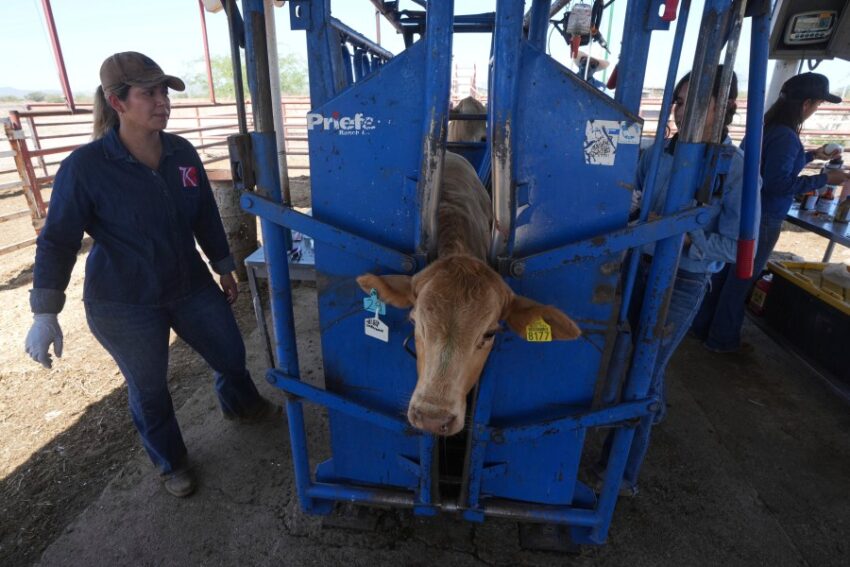McALLEN, Texas (Border Report) — The deadly parasitic New World screwworm has been spotted less than 400 miles from the Southwest border and is threatening Texas cattle, lawmakers say.
U.S. Sen. John Cornyn, R-Texas, says the screwworm flies could devastate the state’s cattle industry if it crosses onto U.S. soil.
“A case of the New World screwworm was reported less than 400 miles south of the U.S.-Mexico border,” Cornyn told colleagues Monday on the Senate floor. “It may soon come across the border and lead to an outbreak in our state.”
The screwworm was first reported in Mexico in November and has steadily made its way north since then.
The most northern recent reported case was in Ixhuatlan de Madero, in the state of Veracruz, Mexico, which is about 370 miles south of McAllen, Texas, according to the U.S. Department of Agriculture.

“This would be absolutely devastating to places like Texas, but also to the entire country,” Cornyn says.
Cornyn says an outbreak could cost Texas livestock producers approximately $1 billion and cost the general economy $3.7 billion.
Texas is the No. 1 cattle-producing state in the country. Other cattle states like California, New Mexico, and Nebraska also could be seriously affected.
And consumers could see the price of food, especially beef, go up at grocery stores and restaurants.

Zapata County Judge Joe Rathmell, who also is a rancher, says border ranchers in South Texas have for years had to regularly screen and treat cattle for deer ticks. He says the threat of the New World screwworm infecting and killing herds is more than he can handle.
“Now the major concern is hopefully the screwworm won’t make it our way,” Rathmell told Border Report last week from his office in the county’s courthouse.
“It would place a big hurt on any ranchers trying to handle cattle down here,” he said. “And certainly wildlife would be susceptible to large infections. And especially the male buck population would be imperiled if it gets here.”
Wildlife, like deer and exotic game, have been a burgeoning business in this rural county of just 15,000 east of Laredo.
“Reports of it only 300 miles from the border certainly is bringing attention,” Rathmell said.
U.S. Agriculture Secretary Brooke Rollins came to the Rio Grande Valley last month and announced over $8 million in federal funds to launch planes full of sterile male screwworms from a former Air Force Base in western Hidalgo County to infection zones in Mexico.

Mexican farmers have been struggling to identify and treat cattle and there are reports that the price of treatment remedies has skyrocketed in Mexico and is financially out of range for many. There even are reports that some ranchers are dousing infected cattle with gasoline and some are using tweezers to pull out the screwworms.
The New World screwworm is a fly. When it is in its larvae stage, it they can infect and kill livestock. Female screwworms seek out odorous areas to lay their eggs, including sores and cuts. The larvae have screw-like appendages that burrow into the animal, causing further infections.
Cornyn says an infected animal can die within a week.
In May, Cornyn and U.S. Rep. Tony Gonzales, R-Texas, filed legislation that would fund a $300 million facility in the United States to begin production of a new sterile fly facility to combat the spread of New World screwworm.
U.S. Rep. Monica De La Cruz, R-Texas, sent a letter to Rollins in May asking that the facility be built at Moore Air Base, the same facility where planes are flying out Hidalgo County carrying the sterile flies.
“Ag producers across America are sounding the alarm — the New World screwworm is making a comeback, and our livestock industry is in real danger. We need to fully eradicate this pest before it’s too late,” Gonzales said.
Any proactive steps we can take now will provide future benefits for farmers, ranchers and the livestock they care for,” American Farm Bureau Federation President Zippy Duvall said when the legislation was filed.
Establishing a sterile fly facility in the United States will ensure continued action to prevent the spread of New World Screwworm and protect our cattle herd, nation’s food supply, and the livelihoods of countless farmers and ranchers,” said Brody Peak, chairman of Livestock Marketing Association’s Government and Industry Affairs Committee.
Sandra Sanchez can be reached at SSanchez@BorderReport.com.
 Read: Read More
Read: Read More




